Fansmanship Podcast Episode 217 – Chris Sylvester and Brint Wahlberg
It’s another podcast episode! Cal Poly basketball teams are at the Big...
Taking sports photos is a crapshoot wrapped in a outer shell of competence and preparation. Sometimes, you know a great shot’s coming. Other times, it’s a surprise until you get home. Different sports require varying skill levels and on Saturday night at Mott, two or three sweet plays and the resulting photos were some of the best of the year.
Photographer Ray Ambler is someone who has appeared on the Fansmanship Podcast and is at a ton of Cal Poly games. You can find his photos at RAPhotos.com. He pretty much dominates Arroyo Grande and Five Cities. We are always crossing paths, and I asked him to talk to me about what goes through his mind during any particular big play.
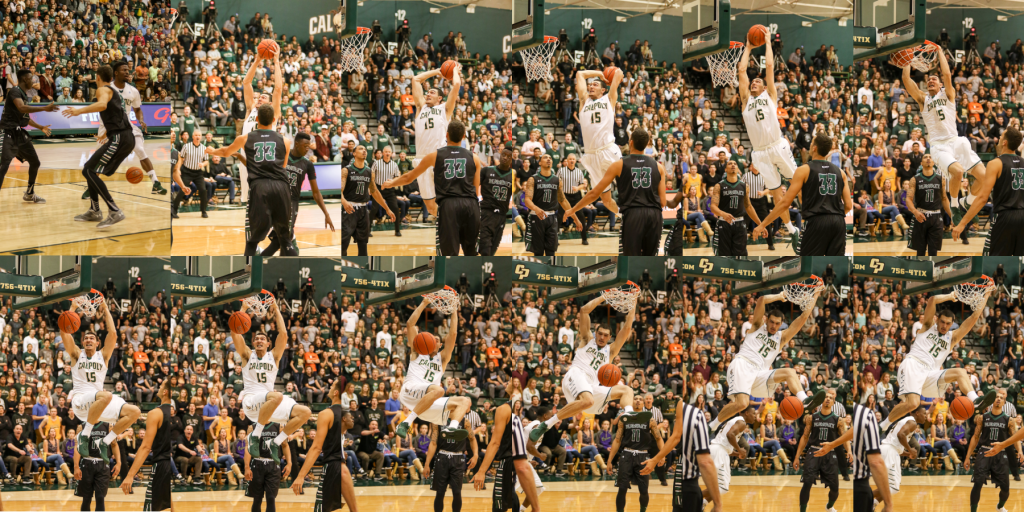
When the play comes right at you and you’re able to capture it in focus… that’s a good feeling. By Owen Main
His first thought on a play like the Josh Martin dunk on Saturday night is the same as mine:
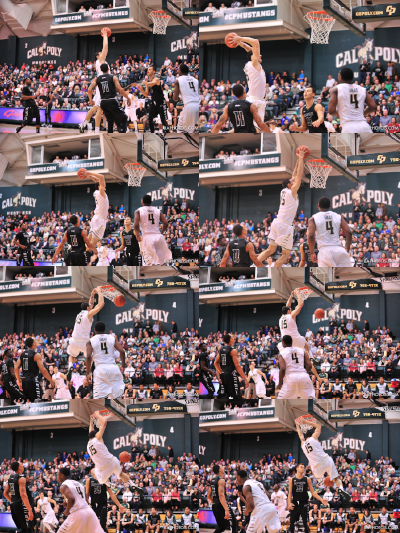
Ray had everything right. The subject is in-focus and he got stayed with Martin all the way through. Sometimes, the play just doesn’t come straight at you like you’d like it to. By Ray Ambler – RAPhotos.com
“My first thought on a fast-break is, is this a dunk coming?” said Ambler. “Sometimes, you don’t have time to think, sometimes, it is telegraphed. I will be on the alley-oop guy coming down the court and then the dunker is sneaking and at the last moment, you realize what is going on. On those… hit the button and pray.”
On the Martin fast-break dunk. David Nwaba dribbled quickly into the front court. Because it’s easier to capture a rim attack with a portrait-style photo, I usually turn my camera when there’s an impending drive. Ambler has a full-frame sensor, so he doesn’t have to.
“On the Josh Martin dunk last night. I thought Dave was going in,” said Ambler. “At the last minute, the ref stepped in my way and I missed the pass between the legs, but I was able to react to Josh’s reaction — Except he went the wrong way for me.”
I said “damn,” and peaked around the basket to see [Owen] standing in the bench corner. My first thought was, I bet Owen got it.”
While I deal with a cropped sensor (more zoomed-in), forcing me to shoot in portrait orientation, Ray had a full-frame one and was able to keep it in landscape orientation. It’s one of the several choices photographers have to make on every play. The more zoomed-in sensor has been effective when it comes to sports like football, baseball, and soccer, but isn’t ideal for things like basketball.
Once you take the photos of the play, and hopefully the reaction of both the crowd and players, the game eventually pauses.
“Then you go through your photos at the time-out,” said Ambler, who will often share and compare shots with me during a game.
Over time, the group of photographers forms a kind of informal competition to see who shot a play the best.
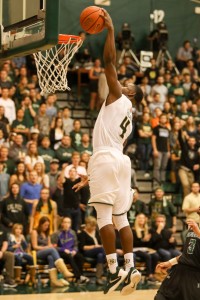
After I got the better of the Martin dunk, the tables turned when Shead went coast to coast. By Owen Main
“It’s fun. After Jaylen’ dunk last night, all three of us in the corner – Laura [Dickenson, from the Tribune], Matt [Yoon, from Cal Poly] and I all checked out each others’ angles. All of us got good shots of that one. It’s cool to see the different shots and who hit the button at exactly the right time. I think Laura really won that one.”
You can see Dickinson’s photos of the Shead dunk and the rest of the game here.
While I definitely got the better photo of the Martin dunk, Shead’s left-handed jam meant his face and front of his body were opened toward the corner with the other three photographers in it. The first half of the Cal Poly – Hawai’i game was a microchasm of what can happen when you choose to shoot from a little different angle.
While focus, anticipation, and understanding of the game you’re shooting will all be crucial, the first big decision as a sports photographer is where to locate yourself. In basketball, sitting on the baseline can get monotonous. For this reason, I’ll sometimes move up to the top of Mott if there is room (or if my friends let me sit with them for a minute). From the top, you’re afforded a different view, which I got lucky with for this Josh Martin dunk against UC Irvine.
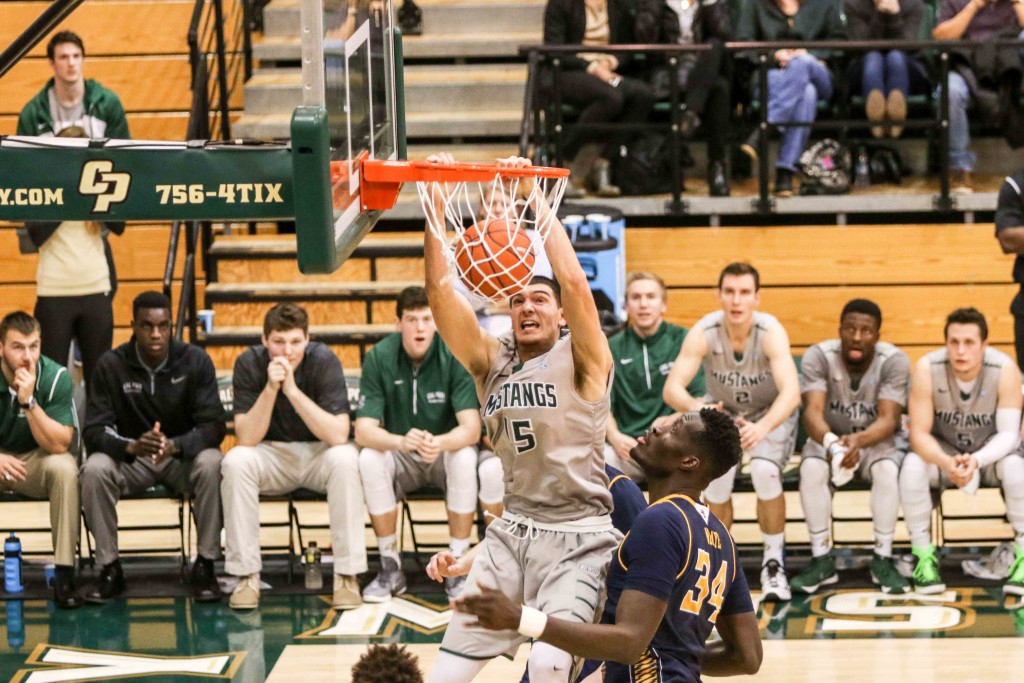
The Martin dunk against UCI with a varied vantage point. By Owen Main
I was only in that seat for about three minutes, but I got an awesome shot — and moved along.
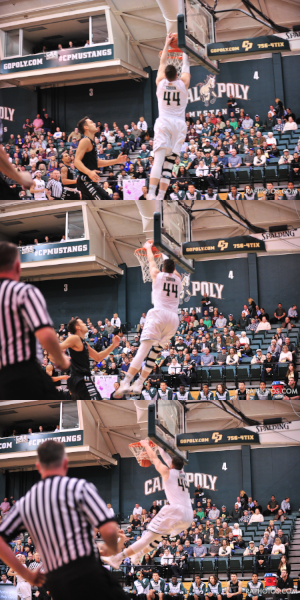 What are you thinking?
What are you thinking?Knowing the game helps a lot. In football, being able to anticipate a quarterback pitch in Cal Poly’s triple-option offense is crucial. In volleyball, you might pick up on who the team is trying to set (Adlee VanWinden, for example). In baseball, being prepared for a steal or pick-off play can result in a great picture of a slide and tag, if you’re ready to point at the right thing.
In most sports, a referee or umpire can get in your way really easily. Usually, they’re trying to get the best look at the play and if you’re in TOO good position, sometimes all that ends up in your shot is blurry stripes.
On this sequence of a Zach Gordon alley-oop slam (left, Photos by Ray Ambler) in the first half of last week’s game, Ray was lucky that the official didn’t move to his right a little earlier, but the quick alley-oop can be the trickiest thing to shoot. Whenever your camera is moving quickly from one position to another, focus isn’t guaranteed.
In this case, the photos look OK when they aren’t that big, but they’re a little out of focus. I’m not bagging on Ray here either. I probably trash about 75 percent of the photos I take at a given game before editing about 50 percent of the ones I keep.
There wasn’t a ton to talk or write about after Cal Poly’s 75-60 loss to Hawai’i. The Mustangs once again looked like they could play right with a very good opponent and in the second half they once again had issues. You can catch Lucas Clark’s really good game story here or check-out Joe Callero’s post-game comments at the bottom of this post.
Thanks to Ray for contributing his photos and time. To view all of my photos from the game, please click here.
It’s another podcast episode! Cal Poly basketball teams are at the Big...
One of my favorite authors, Jeff Pearlman joins this edition of the...
Donovan Fields is one of the most joyous basketball players I’ve ever...
With the tournament more than underway and the sweet sixteen fast approaching,...
(Article by Luke “Loco” Johnson. Forgive website faux pas.) The genius of...
* Team Records accurate as of Friday morning, 8:39 A.M. The hyped hoopla...
